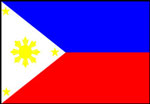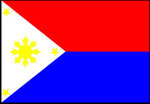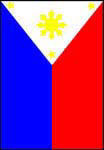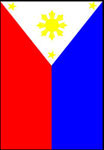Tribung
Pinoy
The
Philippines
Brief
History
Philippine
Government
The
Gateway
Economic
Profile
Arts
& Culture
Indigenous
People
Speak
Filipino
Music
& Song
Photo
Gallery
Important
Links
What's New?
Links to Philippine media
organizations, embassies & consulates,
public and private offices and organizations.
Click here
Philippine Flag
Click here
National Anthem
Click here
|
The Philippine Flag
 The Philippine Flag is the national emblem of the country. It stands for national unity and national identity. It expresses the
Filipino sentiments for freedom, equality, justice and nobility.
The Philippine Flag is the national emblem of the country. It stands for national unity and national identity. It expresses the
Filipino sentiments for freedom, equality, justice and nobility.
Symbols of the Flag
The triangle with equal sides on the left of the flag is symbolic of equality among men.
The eight rays of the sun in the triangle represent the eight provinces that revolted against Spanish rule.
The three stars in each corner of the triangle stand for the three geographical divisions of the country -- Luzon, Visayas and
Mindanao.
The red stripe means the willingness of the Filipino people to shed blood in defense of their country.
The blue stands for common unity and the noble aspirations of the Filipino people.
Reverence for the Flag
The flag should be displayed in all public office buildings, official residences, public squares and institutions of learning every day
of the year.
It should be raised at sunrise and lowered at sundown.
Important Rules

In time of peace |

In time of war |

In time of peace |

In time of war |
When flown from a flagpole, the flag should have its blue stripe on top in time of peace and the red on top in time of war.
When not flown from a flagpole or staff, the flag should be displayed either vertically or horizontally.
When displayed vertically, the triangle should be on top. The blue field should be to the right (left of the observer) in time of
peace, and the red field to the right (left of the observer) in time of war.
When displayed horizontally, the blue stripe should be on top and the triangle at the left of the observer. In time of war, the
red stripe should be on top.
When the flag is flown at half-mast to symbolize mourning, it must first be raised to full mast, allowing it to fly there for a
moment before bringing it down to half-mast. To lower the flag at sunset of at any other time when ordered, it must again be
raised to full mast before it is brought down.
Flag Ceremonies
All members of the Armed Forces and those belonging to semi-military and police organizations in uniform should adopt the
military salute provided in their regulations.
Civilians if outdoors should stand at attention, and if wearing hats should uncover and hold the hats over their hearts.
Complete silence should be observed and no person should be allowed to walk while the ceremony is going on.
The flag should be displayed only from sunrise to sunset, or at such times as may be designated by the proper authorities. It
should be displayed on national holidays and on historical and special occasions.
When the national flag is borne in a parade with those of foreign nations, it should always be in front of the center of the line of
the other flags.
When the flag is displayed on a small staff as in a parade, mourning is indicated by attaching two small streamers of black
crepe to the spearhead, allowing the streamers to fall naturally. Crepe streamers may thus be used by order of the President of
the Philippines.
When a number of flags are grouped and displayed from staffs, the Philippine flag should be in the center at the highest point.
When used to cover a casket, the triangle should be over the head and the blue stripe over the right side of the body. The flag
should not touch the ground. The casket should be carried foot first.
When flown with flags or pennants of organizations on the same halyard (rope), the Philippine flag should always be at the
peak.
When mounted on a platform, the flag should be placed on the presiding officer's right and a bit in front, as he faces the
congregation. Other flags should be on his left.
When displayed with another flag against a wall from crossed staffs, the Philippine flag should be on its own right, and its
staff should be in front of the staff of the other flag. Two Philippine flags should never be thus displayed.
When used on a speaker's platform without the staff, it should be displayed horizontally and placed above and behind the
speaker. It should never be used to cover the speaker's desk or to drape over the front of the platform.
The flag should be flown from a staff when displayed on a float.
The flag should not be embroidered on clothes, or on any piece of cloth. It should not be used as part of a costume.
The flag should not be used as unveiling material in unveiling ceremonies.
The flag should not be displayed in cockpits, dance halls and centers of vice.
Discard all old and tattered flags. Worn-out flags should be destroyed privately, preferably by burning.
When displayed over the middle of a street, as between buildings, the flag should be suspended vertically with the blue
stripe to the north in an east-and-west street, or the east in a north-an-south street.
The flag should not be sued for decorations. Use buntings. In using the colors of the flag, the blue color in the bunting should
be at the top. The correct order of the colors is blue-white-red.
|